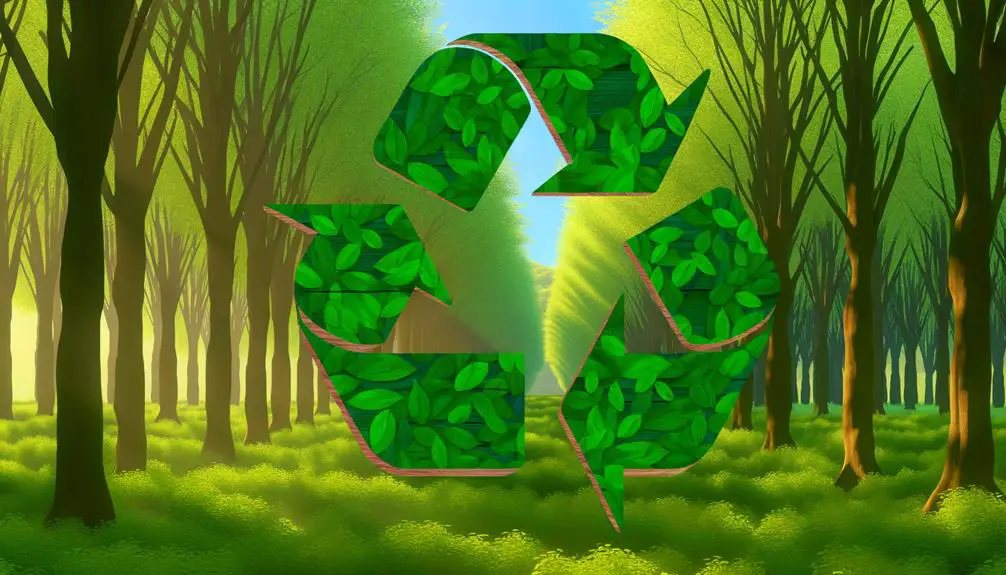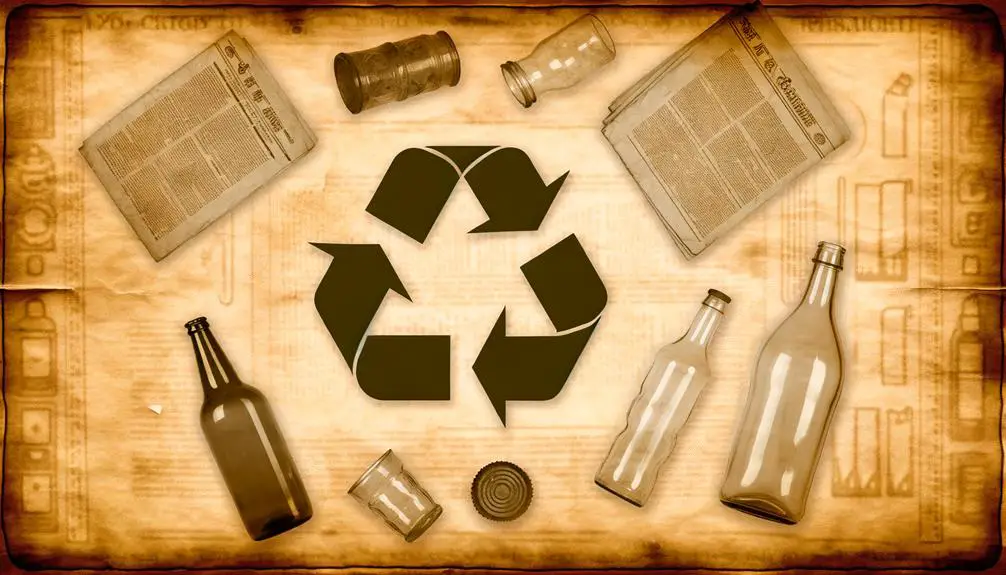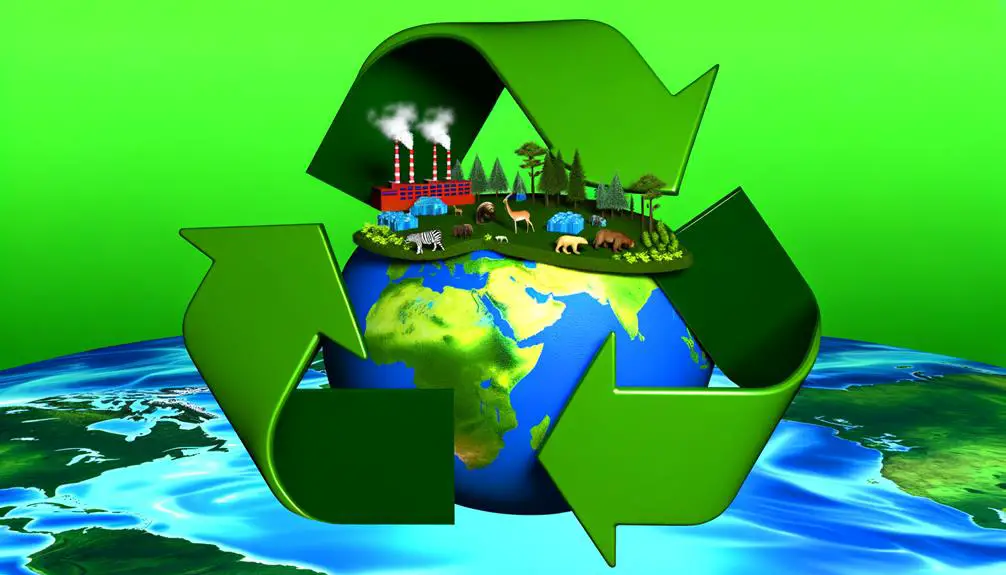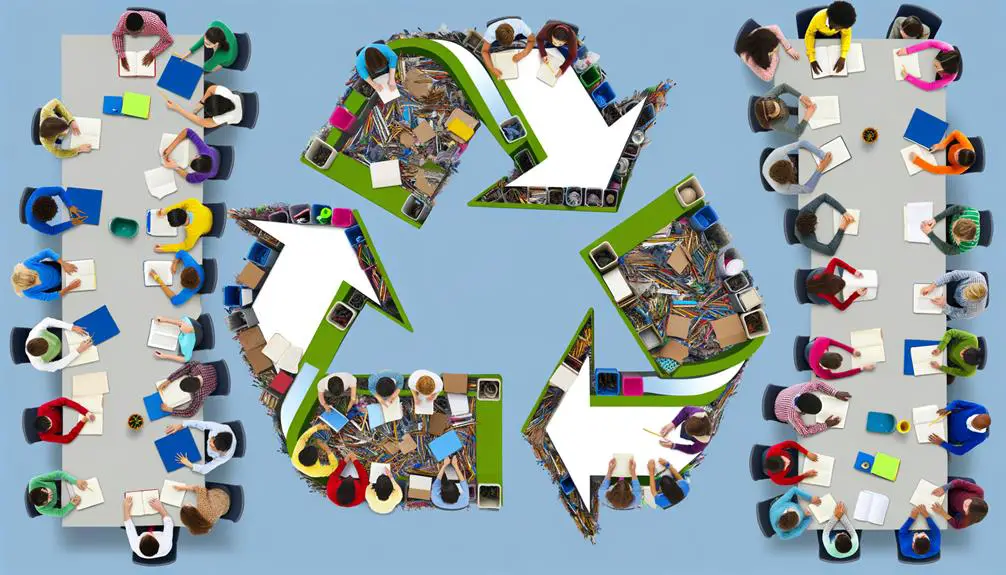What Is the Recycle Symbol and Its Meaning?
The recycling symbol, created in 1970 by Gary Anderson, is an iconic representation of sustainability. Its three interlocking arrows form a triangle, symbolizing the cyclical nature of reduction, reuse, and recycling.
The design conveys continuity and unity in environmental efforts. Variations of the symbol indicate specific recycling instructions for different materials.
Globally recognized, its green color underscores eco-friendliness and sustainable practices. This symbol guides legal frameworks, educates the public on eco-conscious behaviors, and underscores the importance of minimizing our carbon footprint.
Engaging with the nuances of this symbol reveals more about its integral role in global sustainability efforts.

Key Takeaways
- The recycling symbol, designed in 1970, uses three arrows to represent reduction, reuse, and recycling.
- Its triangular shape symbolizes continuity and sustainability, emphasizing collective environmental responsibility.
- The green color of the symbol conveys eco-friendliness and promotes environmental awareness.
- Variations of the recycling symbol include the Mobius loop for different plastics and specialized symbols for various materials.
- The symbol encourages participation in recycling, reduces contamination, and supports a closed-loop system to minimize carbon footprints.
History of the Recycling Symbol

The recycling symbol, an internationally recognized emblem, was created in 1970 as part of a contest held by the Container Corporation of America to promote environmental awareness. The contest was initiated amid the burgeoning environmental movement, with the first Earth Day celebrated the same year.
Gary Anderson, a 23-year-old college student, won with his simple yet impactful design. This emblem quickly became a powerful visual cue for recycling efforts worldwide. Anderson's creation not only captured the essence of recycling with its continuous loop but also underscored the importance of sustainability.
Over the decades, the recycling symbol has become synonymous with eco-friendly practices, serving as an enduring reminder of the collective responsibility to protect our planet.
Design and Structure
Characterized by its three following arrows forming a triangular shape, the design of the recycling symbol encapsulates the principles of reduction, reuse, and recycling in a visually compelling way. The triangular configuration is not only visually pleasing but also symbolically potent, representing an endless loop of sustainability. The arrows seamlessly flow into one another, highlighting continuity and the cyclical nature of recycling processes.
| Aspect | Description | Significance |
|---|---|---|
| Shape | Triangular | Symbolizes continuity |
| Arrows | Three sequential arrows | Represents reduction, reuse, recycling |
| Color | Typically green | Conveys eco-friendliness |
| Orientation | Clockwise or counterclockwise | Indicates cyclical process |
This thoughtful design guarantees instant recognition and serves as a universal reminder of the importance of sustainable practices.
The Three Arrows

Each of the three arrows in the recycling symbol represents a distinct phase in the lifecycle of a recyclable material: collection and processing, manufacturing into new products, and purchasing those products to restart the cycle.
This cyclical process guarantees the sustainability of materials and minimizes environmental impact.
- Collection and Processing: Recyclable materials are gathered and sorted, reducing landfill waste.
- Manufacturing: Processed materials are transformed into new products, conserving natural resources.
- Purchasing: Consumers buy products made from recycled materials, closing the loop and promoting a sustainable economy.
Understanding these phases highlights the importance of each step in the recycling process, encouraging active participation and fostering a culture of environmental stewardship.
This closed-loop system is essential for reducing carbon footprints and conserving resources.
Variations and Adaptations
Numerous alterations and adjustments of the recycling symbol have emerged to address specific recycling guidelines and promote broader environmental awareness.
For instance, the Mobius loop, often altered with numerical identifiers, designates different types of recyclable plastics.
Additionally, some modifications incorporate text such as 'Please Recycle' to encourage active participation.
Specialized symbols, like those for electronics, batteries, and compostable materials, provide clarity on proper disposal methods.
These variations ensure that consumers can easily identify the correct recycling protocol for various materials, minimizing contamination in recycling streams.
Recycling Symbol Colors

The colors of the recycling symbol are not arbitrary; they convey specific messages that enhance public understanding. Green signifies sustainability and environmental stewardship.
Blue represents trust and reliability, and black is often used for specialty recycling, such as electronic waste.
These color distinctions help in effectively communicating the purpose and importance of recycling initiatives.
Green for Sustainability
Often acknowledged as a universal indicator, the green color in recycling symbols signifies a strong commitment to sustainability and environmental stewardship. This color choice is not random; it has deep-rooted connections to nature and ecological balance.
The adoption of green in recycling logos serves several key purposes:
- Encourages Positive Environmental Actions: Green encourages a sense of responsibility towards the planet.
- Symbolizes Renewable Resources: It emphasizes the importance of using resources that can be replenished.
- Promotes Eco-Friendly Practices: Green indicates to consumers that the products or services adhere to sustainable practices.
Empirical studies show that green is associated with perceptions of health and energy, reinforcing its role in promoting sustainable habits. Therefore, the green recycling symbol is a powerful tool in environmental advocacy.
Blue for Trust
Blue, a color synonymous with trust and reliability, plays a pivotal role in the effectiveness of recycling symbols by fostering consumer confidence in sustainable practices. This color choice is not arbitrary; evidence suggests that blue hues can notably enhance the perceived credibility and dependability of environmental initiatives. When consumers encounter blue recycling symbols, they are more likely to trust the efficacy of the recycling process, thereby boosting participation rates.
| Element | Impact |
|---|---|
| Trust | Enhances credibility |
| Reliability | Promotes consistency |
| Consumer Confidence | Increases participation |
Black for Specialty
Black recycling symbols are often designated for specialty materials, signaling a distinct category that requires unique handling or processing methods. This color coding is essential for ensuring that materials are properly sorted and processed, minimizing contamination and maximizing recycling efficiency.
Specialty materials typically include items that are not part of standard recycling streams and necessitate specific protocols.
- Electronic waste (e-waste): Includes items like old computers, phones, and batteries, which contain hazardous materials.
- Medical waste: Encompasses disposable medical supplies and equipment, requiring careful disposal to prevent contamination.
- Hazardous materials: Covers substances such as chemicals, paints, and solvents that need specialized treatment.
Understanding these distinctions helps improve recycling practices and supports sustainable environmental management.
Global Recognition
The recycling symbol has achieved global recognition, becoming a universal emblem for environmental conservation efforts across diverse cultures and nations. Its simple design—three chasing arrows forming a continuous loop—transcends language barriers, enabling widespread comprehension and adoption.
According to a 2017 study by the Environmental Protection Agency (EPA), over 90% of surveyed individuals in the United States recognized the symbol and associated it with recycling practices. This widespread recognition is mirrored internationally, as the symbol is prominently displayed on packaging, disposal bins, and educational materials worldwide.
Its ubiquity underscores a collective commitment to sustainability, fostering a sense of global unity in tackling waste management challenges. This universal recognition has notably contributed to promoting recycling behaviors and sustainable practices globally.
Environmental Impact

Recycling initiatives have notably mitigated the strain on natural resources, reducing the need for raw material extraction and lowering greenhouse gas emissions. By repurposing materials, the environmental footprint associated with production processes is notably diminished.
The benefits of recycling extend beyond resource conservation:
- Reduction in Landfill Waste: Recycling decreases the volume of waste that ends up in landfills, thereby reducing soil and water contamination.
- Energy Savings: Producing goods from recycled materials consumes less energy compared to manufacturing from virgin resources.
- Biodiversity Protection: Lower demand for new materials helps preserve natural habitats and biodiversity by reducing deforestation and mining activities.
These factors collectively underscore the pivotal role of recycling in fostering a sustainable environment.
Legal and Regulatory Aspects
Establishing robust legal and regulatory frameworks is essential for ensuring the efficacy and compliance of recycling programs. Governments worldwide implement legislation to standardize recycling symbols and procedures, ensuring clarity and uniformity for consumers and businesses.
The European Union enforces stringent directives under the Waste Framework Directive, mandating member states to comply with specific recycling targets. In the United States, the Resource Conservation and Recovery Act (RCRA) regulates the management of hazardous and non-hazardous waste, promoting recycling.
These frameworks not only set legal recycling standards but also impose penalties for non-compliance, thereby motivating adherence. Consequently, such regulations foster a systematic approach to waste management, enhancing the overall effectiveness of recycling initiatives.
Role in Education

The symbol of recycling serves as a pivotal tool in educational settings, fostering environmental awareness through targeted programs. Integrating recycling concepts into curricula not only enriches students' understanding of sustainability but also equips them with practical strategies for environmental stewardship.
Engaging students in hands-on activities and community projects enhances their commitment to recycling and promotes a culture of ecological responsibility.
Environmental Awareness Programs
Given the escalating environmental challenges, integrating environmental awareness programs into educational curricula is paramount for fostering a sustainable future. These programs provide students with critical knowledge and skills to address environmental issues effectively.
Enhanced Critical Thinking: Students learn to analyze environmental problems and devise innovative solutions.
Practical Engagement: Hands-on activities, such as recycling projects, foster a deeper understanding and commitment to sustainability.
Community Involvement: By participating in local environmental initiatives, students can influence positive change within their communities.
Studies indicate that early education in environmental stewardship leads to lifelong sustainable practices. By embedding these programs into the educational framework, we cultivate a generation equipped to tackle environmental challenges proactively. Such initiatives are essential for driving collective action towards a greener future.
Curriculum Integration Benefits
Integrating environmental education into the curriculum yields significant benefits, equipping students with the knowledge and skills necessary for sustainable living. Research indicates that embedding recycling and sustainability concepts into various subjects enhances critical thinking and problem-solving abilities.
For instance, students can learn about the science behind recycling in chemistry, understand its economic impacts in economics, and explore societal implications in social studies. This all-encompassing approach fosters environmental stewardship from a young age, promoting responsible behavior and informed decision-making.
Additionally, curriculum integration prepares students for green careers, aligning educational outcomes with job market demands. By cultivating an environmentally conscious mindset, educational institutions play a pivotal role in advancing global sustainability efforts.
Student Engagement Strategies
Effective student engagement strategies are essential in fostering a deep understanding of recycling and sustainability concepts, thereby promoting active participation and long-term retention of environmental education. Implementing these strategies can greatly enhance the learning experience and encourage proactive behavior in students.
Key approaches include:
- Interactive Learning: Utilizing hands-on projects and real-life simulations to make recycling concepts tangible.
- Collaborative Activities: Encouraging group work and peer discussions to build a community-focused mindset.
- Technology Integration: Leveraging digital tools and apps to create dynamic and engaging content.
These evidence-based methods not only facilitate comprehension but also instill a sense of responsibility and commitment towards sustainable practices. By actively engaging students, educators can cultivate environmentally conscious individuals prepared to make a positive impact.
Consumer Awareness
Consumer awareness plays a central role in the effectiveness of recycling initiatives, as informed individuals are more likely to participate in and advocate for sustainable practices. Knowledge of what can and cannot be recycled, understanding the environmental impact of waste, and recognizing the recycling symbol are all vital components.
| Issue | Impact | Solution |
|---|---|---|
| Lack of Information | Improper recycling practices | Educational campaigns |
| Misconceptions | Contamination of recyclables | Clear guidelines and labeling |
| Inconsistent Policies | Confusion among consumers | Standardized recycling systems |
| Awareness Gaps | Low participation rates | Community outreach programs |
Empirical studies show that targeted educational efforts notably improve recycling rates and reduce contamination. Engaging consumers through clear, consistent information fosters a culture of sustainability.
Future of the Recycling Symbol

As society progresses towards more sustainable practices, the evolution of the recycling symbol will play an important role in guiding and inspiring future generations. Emerging trends indicate that this iconic symbol will need to adapt to new environmental challenges and technological advancements.
Key areas of focus include:
- Digital Integration: Enhanced QR codes could link to detailed recycling instructions, making it easier for consumers to recycle correctly.
- Material-Specific Symbols: Different designs for plastics, metals, and electronics may provide clearer guidance on disposal methods.
- Global Standardization: A universally recognized symbol could harmonize recycling efforts across borders, improving global waste management.
Conclusion
The recycling symbol, with its three chasing arrows, has become a global icon of sustainability and environmental responsibility.
Surprisingly, a survey revealed that over 85% of consumers recognize the symbol, underscoring its pervasive influence.
Its various adaptations and color schemes cater to different regulatory and educational needs, making it a versatile tool for promoting recycling practices.
Continued evolution of the symbol will likely enhance consumer awareness and bolster global recycling efforts.






